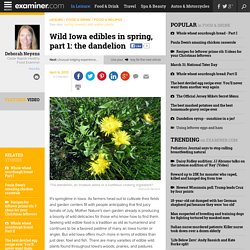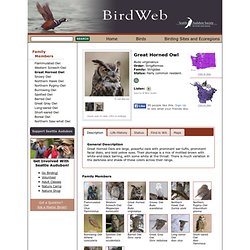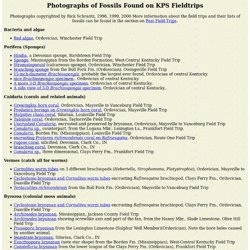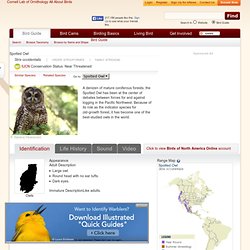

130+ edible wild plants: A foraging reference listing both common and less-known wild edibles from agave to Yaupon holly. Abuse survivor, Astrology and Signs. Pinterest. Identification Guides: Animal Skulls & Bird Feathers - Waking Up Wild. Wild Iowa edibles in spring, part 1: the dandelion. It's springtime in Iowa.

As farmers head out to cultivate their fields and garden centers fill with people anticipating that first juicy tomato of July, Mother Nature's own garden already is producing a bounty of wild delicacies for those who know how to find them. Seeking wild edible food is a tradition as old as humankind and continues to be a favored pastime of many an Iowa hunter or angler. But wild Iowa offers much more in terms of edibles than just deer, fowl and fish. There are many varieties of edible wild plants found throughout Iowa's woods, prairies, and pastures. There may even be some growing in your own backyard.
The dandelionAnyone who's visited one of the wineries in the Amana Colonies knows that dandelions are used to make wine, but did you know this scourge of lawn lovers everywhere has multiple culinary uses? Krebill began teaching a popular science elective on wild edibles in which students applied their research skills to perfect sumac lemonade. 1. Preparation:1. Edible Plants, Asparagus and Medicinal Plants. Plant Iowa Native. Foraging Guide - Edible Wild Plants of Temperate North America and the UK. Now FREE!!

Image page of the Rose profile. The Mobile Foraging Companion is a feature-laden, cross-platform guide for common wild and naturalised edible plants of temperate North America, and Britain and Northern Europe (there is a guide for each of those two areas, to suit your needs). Whether you forage on a leisurely weekend walk, want to know about that weed in the garden, or want to prepare for a potential survival situation, this guide is one of the handiest reference guides on foraging. It is designed for quick access to all the essential information you want at your fingertips, no more wading through long text to find the facts you are looking for. This unique guide packs a lot of information into a small space: What is the difference between the N.
Birds of Prey.pdf. The Magpie Nest: Walnut Ink. Walnut Ink I’ve been learning how to dye fabric.

Not in a very elaborate way—the kind you throw in the washing machine and keep the poor thing returning to the beginning of its cycle for half an hour, till all your cheesecloth is a tangled shroud. The fun part, though, has been learning how to dip the ends of the cheesecloth in some walnut ink I made last year (I had three quarts left, which was never going to get used on paper—a small bottle can last three years; it’s a full sepia color). The walnut gunge just seeps up into the cotton—it’s beautiful, a deep rich brown fading into buff. I don’t know quite what to use as a mordant, a chemical that forces the pigment to adhere permanently to the fibre, though alum and tara (whatever that is) appeared in a Google search this morning.
How to make walnut ink: Mike's YBYG Archives. Identify Owls of the US - A Who's Who of Owls, Owl Calls, Identification, and Cultural Sigificance. Great Horned Owl. Hover over to view.

Click to enlarge. Bubo virginianus Fairly common resident. General Description Great Horned Owls are large, powerful owls with prominent ear-tufts, prominent facial disks, and bold yellow eyes. Habitat Great Horned Owls are supreme generalists. Behavior Like most owls, Great Horned Owls have keen hearing and keen vision in low light, both adaptations for hunting at night. Diet Great Horned Owls are opportunistic generalists, taking advantage of whatever prey is available. Nesting Great Horned Owls are early nesters and begin calling in courtship in early winter. Migration Status Great Horned Owls are not considered migratory. Conservation Status Great Horned Owls are widespread and common. Key to Major Groups of Mushrooms. Start. 41 Camping Hacks That Are Borderline Genius. Photographs of Fossils. Photographs copyrighted by Rick Schrantz, 1998, 1999, 2000 More information about the field trips and their lists of fossils can be found in the section on Past Field Trips .

Bacteria and algae Red algae , Ordovician, Winchester Field Trip Porifera (Sponges) Hindia , a Devonian sponge, Bardstown Field Trip Sponge , Mississippian from the Borden Formation, West-Central Kentucky Field Trip Stromatoporoid (calcareous sponge), Ordovician, Winchester Field Trip branching sponge from the Bull Fork Fm. (Ordovician), Owingsville Field Trip 15-inch-diameter Brachiospongia , probably the largest ever found, Ordovician of central Kentucky. Cnidaria (corals and related animals) Vermes (catch all for worms) Byrozoa (colonial moss animals) Brachiopoda (lamp shells) Arthropoda Crustacea Teichochilina jonesi ostracodes from the Lexington Limestone (Ordovician) in Lexington.
Digital art at its finest - inflated animals in Africa. The Feather Atlas - Feather Identification and Scans - U.S. Fish and Wildlife Service Forensics Laboratory. Birds%20of%20Prey. Spotted Owl, Identification. Cornell Lab of Ornithology All About Birds Search in: Bird Guide Spotted Owl Strix occidentalis ORDER: STRIGIFORMES FAMILY: STRIGIDAE IUCN Conservation Status: Near Threatened © Kameron Perensovich A denizen of mature coniferous forests, the Spotted Owl has been at the center of debates between forces for and against logging in the Pacific Northwest.

Sponsored Ad Appearance Owls Typical Voice Adult Description Large owl. Immature Description Like adults. Range Map Help. Owl Owl Owl.